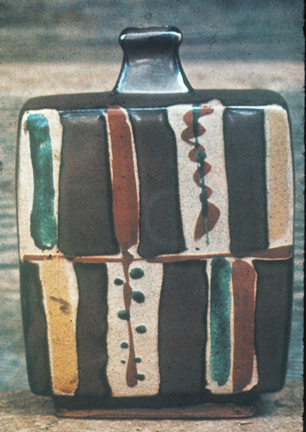Along with Bernard Leach and Soetsu Yanagi, Shoji Hamada was another
potter who had great influence on the development of hand made pottery in
the 20th century. Hamada was no humble country potter, having been educated
in Japan in ceramic engineering at a university. However, this training
did not satisfy his desire to learn about the traditional methods of Japanese
pottery making. He decided to go to Mashiko, a traditional pottery village,
and learn from the local potters. He was not well received however, as the
local potters were very suspicious of this educated urban person, and no
one would take him on as an apprentice. Finally he was given a chance by
a sympathetic potter, and Hamada would make this isolated pottery village
his home for the rest of his life. Hamada was a potter, not a teacher, and
showed little interest in traveling, lecturing, or demonstrating, preferring
to stay in the village and make pottery. He was interested in ideas, and
found the writings of Soetsu Yanagi, author of the book, The Unknown
Craftsman, very influential. Yanagi coined the term mingei, literally
folk art, or art of the people, to describe the crafts made in past centuries
by anonymous individuals in village cultures. Yanagi held that these craftsmen
were not consciously trying to make 'art,' but interestingly, much of this
work is now considered art. He felt that the contemporary artist/potter
was too caught up in the desire to produce art, and the cult of celebrity.
He wrote that this desire would have to be abandoned in order for real art
to be produced. In other words, using an analogy from archery, you can't
hit the bullseye by trying to hit the bullseye. By trying so hard to be
'artists,' craftsmen had lost sight of what was really important: working
with one's hands, naturally and unselfconsciously, using local materials
and traditional techniques to produce meaningful work for one's fellow human
beings. This is what Yanagi meant by the term 'unknown craftsman.' Hamada's
life and work were an example of living by this philosophy. Interestingly,
and proof of Yanagi's theory that 'you can't hit the bullseye by trying
to hit the bullseye,' Hamada would become arguably the century's most famous
potter by not trying to be! In 1955, he was designated by the Japanese government
as an 'intangible national culture treasure,' more often referred to as
a 'national treasure.' The equivalent of a lifetime National Endowment of
the Arts grant, this honor is bestowed by Japan on craftsmen and artists
who are deemed living embodiments of traditions, who through their life
and work, pass on to the next generation skills and knowledge of the traditional
crafts and arts. It was his friendship with the English potter and writer,
Bernard Leach, that would bring Hamada and his work to the public consciousness.
Leach and his work are the subject of the next image.

Stoneware Bottle with wax resist and overglaze decoration
by Shoji Hamada, 1970, Mashiko, Japan


